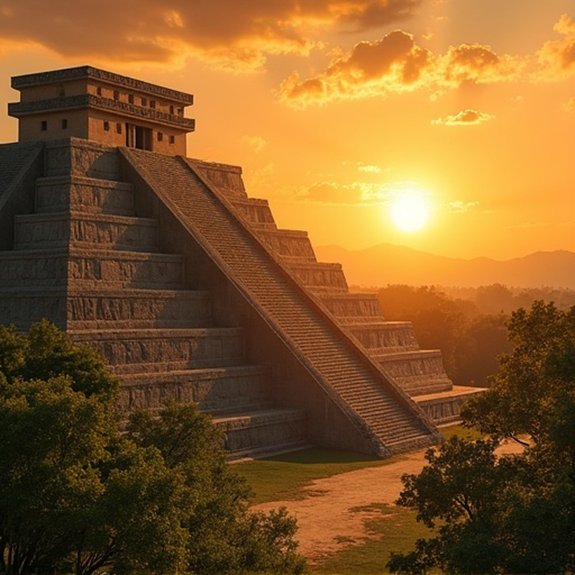The Solar Deity Myths of Mesoamerica
Mesoamerican civilizations didn’t just worship the sun—they built entire worlds around solar deities who controlled everything from harvests to human sacrifice. These gods weren’t distant figures in the sky. They walked among kings, demanded blood offerings, and transformed into jaguars at will. The Olmecs started something extraordinary when they merged feline predators with celestial power, creating a mythological blueprint that would dominate the region for three thousand years.
Introduction

When Spanish conquistadors first encountered the grand temples of Mesoamerica, they couldn’t comprehend the sophisticated religious systems that had flourished for millennia across the region. Solar deities dominated these complex belief systems, reflecting the sun’s essential role in agricultural societies. From the Aztec’s fierce Tonatiuh to the Maya’s multifaceted Kinich Ahau, sun gods embodied creation, destruction, and renewal.
These solar myths weren’t mere stories—they shaped daily life, political power, and cosmic understanding. Rulers claimed divine solar lineage, architects aligned pyramids with solstices, and priests performed elaborate ceremonies to guarantee the sun’s daily journey across the sky. Each civilization developed unique interpretations while sharing core themes: the sun’s battle against darkness, its death and rebirth, and humanity’s debt to solar powers.
Olmec Jaguar-Sun Transformation Beliefs
The Olmec civilization, flourishing between 1500 and 400 BCE, established the foundation for Mesoamerican solar mythology through their distinctive jaguar-sun transformation beliefs. They perceived the sun’s daily journey as a jaguar’s transformation cycle. At dawn, the solar deity emerged as a powerful jaguar, prowling across the sky. By sunset, it descended into the underworld, maintaining its feline form to battle darkness.
Archaeological evidence from La Venta and San Lorenzo reveals were-jaguar figurines with solar symbols, confirming this belief system’s centrality. The Olmec associated jaguars with divine power, linking the predator’s nocturnal hunting prowess to the sun’s ability to conquer night. This duality influenced later civilizations’ solar myths, particularly the Maya and Aztec traditions that incorporated jaguar imagery into their sun god representations.
Notable Cases or Sightings

How did ancient Mesoamericans document their encounters with solar deities beyond mythological texts? They’ve left compelling evidence through codices, temple inscriptions, and ceramic artwork depicting specific celestial events. The Dresden Codex records Maya priests’ observations of solar eclipses they attributed to the jaguar god devouring Kinich Ahau. At Xochicalco, stone carvings detail a 743 CE solar phenomenon witnesses claimed revealed Tonatiuh‘s face within corona streams.
Archaeological evidence from Teotihuacan’s Pyramid of the Sun suggests rulers staged elaborate ceremonies during solar alignments, believing they’d achieved direct communication with the deity. Aztec chroniclers documented Emperor Moctezuma II’s reported vision of Tonatiuh warning about pale strangers’ arrival. These accounts weren’t mere folklore—they’re meticulously recorded observations that shaped political decisions and religious practices throughout Mesoamerican civilizations.
Common Theories or Explanations
While scholars have proposed numerous interpretations of Mesoamerican solar deity beliefs, three dominant theories explain their cultural significance. The agricultural theory suggests these myths emerged from societies’ dependence on solar cycles for crop cultivation. Priests tracked the sun’s movement to determine planting seasons, elevating solar deities to supreme status.
The political legitimacy theory argues rulers exploited solar mythology to justify their authority. They claimed descent from sun gods, positioning themselves as divine intermediaries between celestial and earthly domains.
The cosmological duality theory emphasizes how solar deities represented life’s cyclical nature. The sun’s daily journey symbolized death and rebirth, reflecting Mesoamerican concepts of transformation. These interpretations aren’t mutually exclusive; they often intersected within complex belief systems that shaped civilization development.
Frequently Asked Questions
How Did Spanish Colonization Impact Indigenous Solar Deity Worship Practices?
Spanish colonization forcibly suppressed indigenous solar deity worship through violent conquest, temple destruction, and Catholic conversion campaigns. Colonizers banned traditional ceremonies, burned sacred texts, and punished practitioners, though many communities secretly preserved their beliefs underground.
What Astronomical Phenomena Did Mesoamericans Associate With Their Solar Deities?
Mesoamericans linked their solar deities to eclipses, solstices, equinoxes, and Venus’s movements. They’d track the sun’s daily journey, seasonal changes, and zenith passages. These phenomena determined agricultural cycles, ritual timing, and mythological narratives.
Which Modern Communities Still Practice Solar Deity Rituals Today?
Maya communities in Guatemala and Mexico still perform solar ceremonies at ancient sites. They’ve maintained traditional rituals honoring the sun during solstices and equinoxes, combining pre-Columbian practices with Catholic influences in syncretic celebrations.
How Do Mesoamerican Solar Myths Compare to Egyptian Sun God Beliefs?
Both cultures worshipped sun gods as supreme deities, but Mesoamericans emphasized the sun’s journey through the underworld requiring blood sacrifice, while Egyptians focused on Ra’s daily rebirth and cosmic order without demanding human offerings.
What Archaeological Evidence Supports the Existence of Solar Deity Temples?
Archaeologists’ve discovered numerous solar-aligned temples throughout Mesoamerica. Teotihuacan’s Pyramid of the Sun, Chichen Itza’s El Castillo, and Xochicalco’s Temple of the Feathered Serpent demonstrate precise solar orientations during solstices and equinoxes through their architectural designs.


